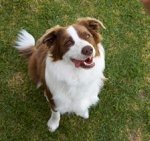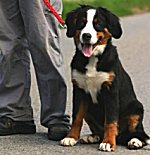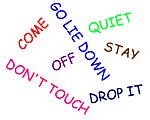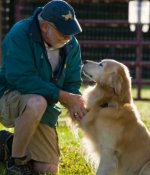English Bull Terriers: What's Good About 'Em, What's Bad About 'Em
English Bull Terrier temperament, personality, training, behavior, pros and cons, advice, and information, by Michele Welton, Dog Trainer, Behavioral Consultant, Author of 15 Dog Books
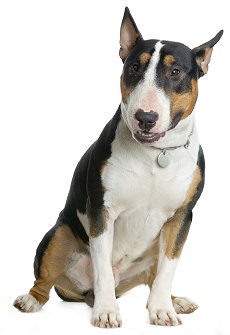
There is a Standard Bull Terrier (medium-sized) and a Miniature Bull Terrier (mid-sized) that are considered separate breeds.
But they have similar temperaments: sweet-tempered, yet also rowdy and clownish, full of fire and determination.
This muscular, forceful, vigorous dog does best with active families, for he has a high energy level that comes in spurts and bursts.
He needs frequent brisk walks, occasional vigorous games of ball, and total immersion in the family, i.e. LOTS of companionship and interactive play sessions.
If ignored, Standard and Miniature Bull Terriers will become bored, and mischief will surely follow. Youngsters who are neglected can be especially rambunctious: happily devouring your furniture and excavating great caverns in your yard.
Most Bullies greet strangers with enthusiastic bounding (often knocking the guest over) and face kissing. However, aggression and timidity are present in some lines, and early socialization is important to develop a stable attitude.
An English Bull Terrier should not be kept with another dog of the same sex, and cats may or may not be safe. Bull Terriers can be very possessive of their food – do not allow another pet or a child to approach a Bull Terrier when he is eating..
At some point, if you have not raised this breed with consistent leadership, he will likely challenge your ability to control his actions. Such dominance attempts must be met with calm assertiveness. Keep training sessions brief but frequent to keep drilling home the commands he needs to learn.
Some Bull Terriers are enthusiastic "talkers" who grunt and mumble to themselves; it's quite amusing.
If you want a dog who...
- Is moderately sized with a muscular build
- Looks very unusual, with an egg-shaped head, large prick ears, and tiny triangular eyes sunk deeply in his head
- Has a short easy-care coat
- Is rowdy and clownish, full of energy and fire
- Thrives on lots of exercise and vigorous athletic games
- Looks imposing, so makes an effective deterrent, but is usually non-aggressive with strangers
A Standard or Miniature English Bull Terrier may be right for you.
If you don't want to deal with...
- Rowdiness, exuberant jumping, and a tendency to play rough
- Destructiveness when bored or left alone too much
- Aggression or fearfulness toward people in some lines, or when not socialized enough
- Aggression toward other dogs and cats
- Strong-willed mind of his own, requiring a confident owner who can take charge
- Shedding – lots of it
- Serious health problems
- Legal liabilities (public perception, future breed bans, insurance problems, increased chance of lawsuits)
A Standard or Miniature English Bull Terrier may not be right for you.
 |
Dog Breed Traits – Which Traits Are Right For You? In this brand new series, I'll help you decide which dog breed traits would best suit you and your family, your home and yard, and your lifestyle, so you can choose the best dog breed for your family. |
Keep in mind that the inheritance of temperament is less predictable than the inheritance of physical traits such as size or shedding. Temperament and behavior are also shaped by raising and training.
FREE eBooks by Michele Welton
![]() "Respect Training for Puppies" and "Teach Your Dog 100 English Words" are free step by step guides to teaching your pup to be calm and well-behaved.
"Respect Training for Puppies" and "Teach Your Dog 100 English Words" are free step by step guides to teaching your pup to be calm and well-behaved.
![]() "11 Things You Must Do Right To Keep Your Dog Healthy and Happy" is a free guide to keeping your dog mentally, physically, and emotionally happy and healthy so you can enjoy a longer lifetime of companionship.
"11 Things You Must Do Right To Keep Your Dog Healthy and Happy" is a free guide to keeping your dog mentally, physically, and emotionally happy and healthy so you can enjoy a longer lifetime of companionship.

- You can avoid some negative traits by choosing an ADULT dog from an animal shelter or rescue group. With an adult dog, you can easily see what you're getting, and plenty of adult Bullies have already proven themselves not to have negative characteristics.
- If you want a puppy, you can avoid some negative traits by choosing the right breeder and the right puppy.
More traits and characteristics of the English Bull Terrier
If I was considering a Bull Terrier, I would be most concerned about...
- Providing enough exercise and mental stimulation. Bull Terriers, whether Standard or Miniature, are very active dogs who need lots of opportunities to vent their high energy. Otherwise they will become rambunctious and bored – which they usually express by destructive chewing. Bored Bull Terriers are famous for chewing through drywall, ripping the stuffing out of sofas, and turning your yard into a moonscape of giant craters.
- Bounciness. Bull Terriers (up to about three years old) can be bulls in a china shop. When they romp and jump, they do so with great vigor, and things can go flying. If you have small children, or if you or anyone who lives with you is elderly or infirm, I do not recommend Bull Terriers, especially those of Standard size. (Unless you happen to find a calm adult dog for adoption.) The temptation to play roughly is simply too strong in young Bull Terrier.
- Providing enough socialization. Many Bull Terriers are friendly and love everyone, but some have protective instincts toward strangers. All Bull Terriers need extensive exposure to friendly people so they learn to recognize the normal behaviors of "good guys." Then they can recognize the difference when someone acts abnormally. Without careful socialization, they may be suspicious of everyone, which is very difficult to live with.
- Potential animal aggression. Many Bull Terriers will not tolerate another dog of the same sex. Some won't tolerate the opposite sex, either. Many Bull Terriers have strong instincts to chase and seize cats and other fleeing creatures.
- The strong temperament. Bull Terriers have an independent mind of their own and are not pushovers to raise and train. They can be manipulative, and many are willful, obstinate, and dominant (they want to be the boss) and will make you prove that you can make them do things. You must show them, through absolute consistency, that you mean what you say.
To teach your Bull Terrier to listen to you, read my free online training programs.
- Shedding and irritating hairs. Bull Terriers shed much more than you might think. Their short rough hairs stick tenaciously to your clothing and furnishings. In addition, people with sensitive skin may develop a rash from contact with the harsh hairs.
- Potential health problems. From heart disease to kidney disease to eye disease to deafness, Bull Terriers are risky in the health department. Read Bull Terrier Health.
- Legal liabilities. An English Bull Terrier is a completely different breed from an American Pit Bull Terrier, but they are often lumped together by public officials and the media as potentially dangerous dogs. Thus, English Bull Terriers may be targeted for future "banning" in certain areas, or refusal of homeowner insurance policies. In this day and age, the legal liabilities of owning any breed that looks intimidating and has a fighting heritage should be seriously considered. People are quicker to sue if such a dog does anything even remotely questionable.
Frankly, most Bull Terriers, both Standard and Miniature, are "too much dog" for the average household to manage.
My best-selling books – now available FREE on my website
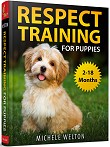 Respect Training For Puppies: 30 seconds to a calm, polite, well-behaved puppy is for puppies 2 to 18 months old. Your puppy will learn the 21 skills that all family dogs need to know. Click here to read for free.
Respect Training For Puppies: 30 seconds to a calm, polite, well-behaved puppy is for puppies 2 to 18 months old. Your puppy will learn the 21 skills that all family dogs need to know. Click here to read for free.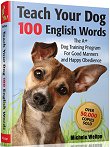 Teach Your Dog 100 English Words is a unique Vocabulary and Respect Training Program that will teach your adult dog to listen to you and do what you say. Click here to read for free.
Teach Your Dog 100 English Words is a unique Vocabulary and Respect Training Program that will teach your adult dog to listen to you and do what you say. Click here to read for free. 11 Things You Must Do Right To Keep Your Dog Healthy and Happy helps your dog live a longer, healthier life. Get my honest advice about all 11 Things before you bring home your new puppy, because some mistakes with early health care cannot be undone. Click here to read for free.
11 Things You Must Do Right To Keep Your Dog Healthy and Happy helps your dog live a longer, healthier life. Get my honest advice about all 11 Things before you bring home your new puppy, because some mistakes with early health care cannot be undone. Click here to read for free.Related posts you might enjoy



